
Page 121-151
85. Agents of biological control were also tried in wounding experiments. Results of studies showed that when a non-decay-causing fungus Trichoderma harzianum was introduced into fresh wounds, along with glycerol, decay was stalled for at least 2 years.
Sections from one tree are shown here. C = Control; G = glycerol; TG = Trichoderma harzianum mycelial and spore culture with 5 ml of glycerol; TGB = as preceding, plus a culture of bacteria commonly isolated from discolored wood. Note decayed wood in sections C and G. The small holes show where wood chips were taken for isolation of microorganisms. The treatment with the fungus isolate used was not as effective when temperatures were low.

Pages 122-123
86. A section from a red maple showing a method used to test the effects of biological agents on the wound response. A wound was inflicted with a chainsaw. Then a metal plate was forced into the center of the wound. The wound on one side of the plate was treated; the other side was left as a control. Because of the way trees compartmentalize wounds, the method is highly applicable.
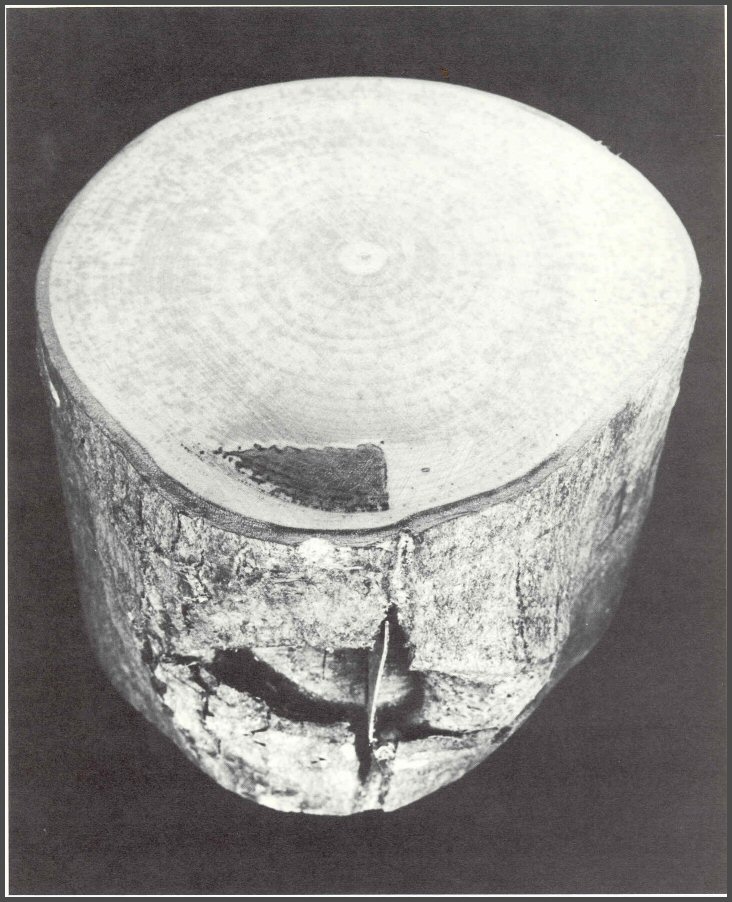
Page 124-125
87. Trees with decayed wood are potential hazards. Trees usually fall as decayed roots break, or trees break at the 2-3-meter trunk level. More dangerous than decayed wood are the vertical cracks. When decayed wood also is associated with cracks on the opposite side of the tree, the tree is a high potential hazard.
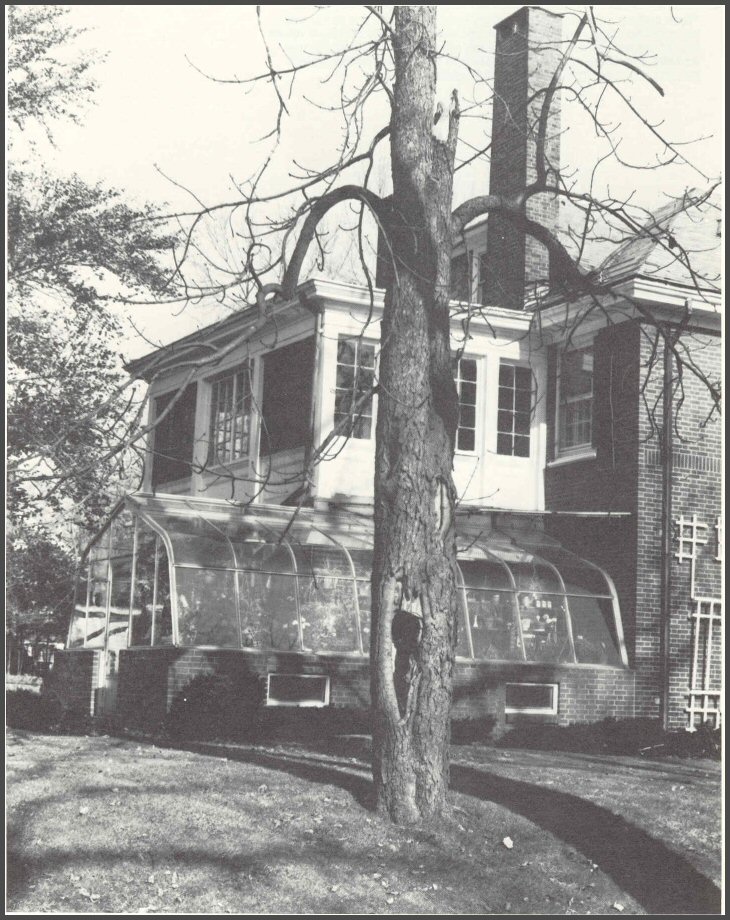
Pages 126-127
88. Hollows in trees are often associated with old, large branch bases. Flush cutting of branches, especially large branches, is a major starting point for large hollows. A flush cut wounds the trunk. Rapid formation of callus follows. The large callus ribs form an oval around the hollows. The U-shaped callus on this tree indicates that the branch was cut too close to the trunk on the upper side.
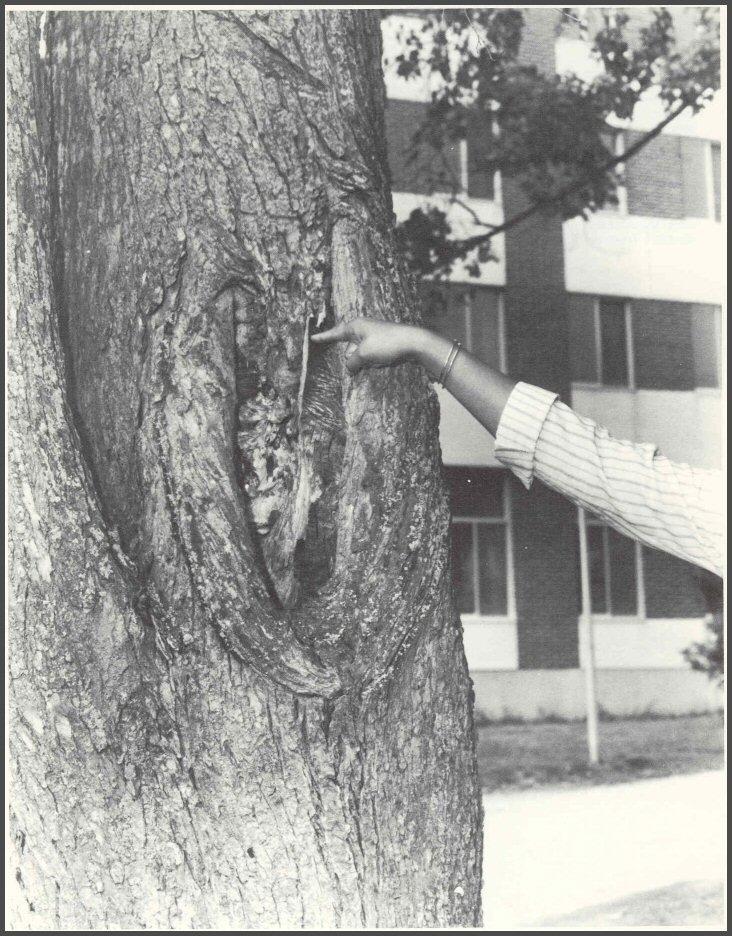
Pages 128-129
89. Along with wound dressings, the filling of cavities was considered the mark of a professional tree expert or tree surgeon. The recommendation has been to clean cavities thoroughly before they are filled. "Thoroughly" meant to chip into the healthy wood behind the decayed wood. We now know that the only reason there is a cavity is that after wounding the tree formed strong boundaries about the injured and infected wood. If a cavity is to be filled, the natural boundary should not be broken. Cavities can be filled for aesthetic reasons, but materials that are coarse or abrasive should be avoided. And above all, clean out only the decayed wood that comes out easily. Do not break the boundaries. Boundaries were broken in this large sugar maple. The concrete shows the edge of the original filling, yet dieback extended far beyond it because of the thorough cleaning. Some practices die slowly. Not only are some trees injured severely by extensive internal cleaning beyond the boundary, but in some trees the protective callus is also destroyed. In attempts to help, man has often caused trees many problems. Much of this results from the desire to "play doctor" or "play dentist". Trees are not animals, and should not be treated like animals.

Pages 130-131
90. Removing dead and dying bark from the margins of fresh wounds can be beneficial to the tree. There is no need to scribe in the form of a vertical ellipse. It is important to cut as shallowly as possible and to round off the margins, especially the top and bottom. More dieback and cracks occur when the top and bottom are strongly pointed.
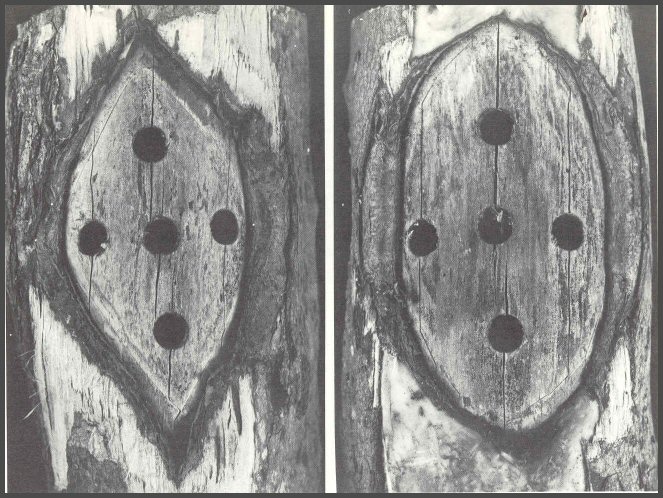
91. Hardware can be placed into trees to help maintain strength. Tubes can be used to drain wetwood fluids, but tubes or holes should not be used to drain water from a cavity. Why the difference? Wet wood is sound wood infected by bacteria. Decayed wood in a cavity is unsound wood. A hole into wet wood will extend the wet wood to the bark. A hole into decayed wood will extend decayed wood to the bark.
Avoid diamond-shaped washers. They cut into the cambium and retard closure, and may increase cambial dieback. Never dead-end hardware into decayed wood. The wood that forms after hardware is inserted does most of the long-term holding. Proper use of hardware can extend greatly the safe and attractive time of a tree.
Discolored wood is on the inner side of this open screw lag in a red oak. The arrow shows the crack that usually forms after insertion of hardware. The open end of the lag is properly set. The new wood will hold for a long time.
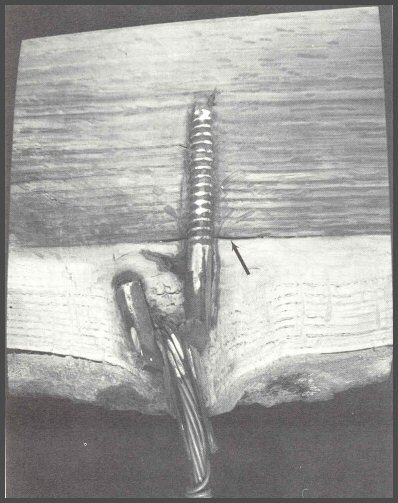
92. Screw lag in a maple. Large arrow shows barrier zone that formed after the screw lag was inserted. The top of the lag went into decayed wood, and it fell away in sample preparation. The small arrow shows the cavity that formed as a result of movement of the lag. This type of lag will have a short life, because the new wood that formed after insertion will not hold it.

Pages 132-133
93. Injections and implants are being used for a great number of reasons, from supplying essential elements to adding many types of chemicals to combat insects and fungi. Care must be taken in the treatment so as not to cause more injury to the tree than it had originally. Injections properly done may be beneficial. Proper injections and implants should be as shallow and as small as possible, and at the base of the tree, not into the roots. The root flare was injected repeatedly on this American elm. American elms usually have 12 to 18 clear, healthy growth rings that store energy reserves. The injections and the associated discolored wood have reduced the energy-holding rings to only a few. Discolored wood is dead wood. It is highly doubtful that injections alone could kill a tree, but the combination of repeated wounds and chemicals that cause long columns of discolored wood could weaken a tree and make it an easy target for other invaders.
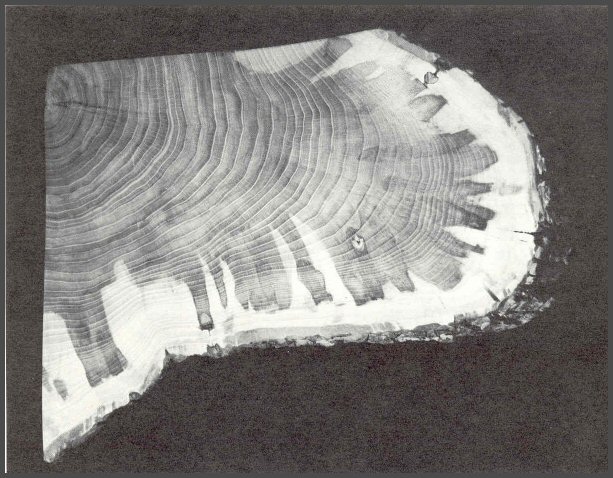
94. The many experiments conducted with drill holes give information applicable to injection wounds. In elm 132, the injection holes that touched the internal column of discolored wood spread to form large columns. The injection holes that were surrounded by clear healthy wood were walled off to small columns. Also, note the decayed wood in the columns that joined with the already present central column. Injections properly spaced in position on the tree butt, and spaced over time, will not cause serious internal injury. When trees are injected repeatedly over time, the discolored columns associated with the injection wounds begin to coalesce. The volume of wood that would normally hold energy reserves is reduced.
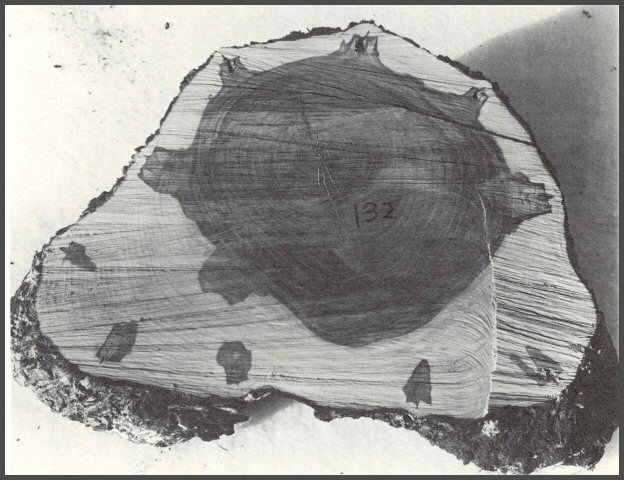
Pages 134-135
95. Most of the transport in a tree occurs in the current growth ring. There is no need to inject beyond this wood. In many cases it is not the wound, but what is put in the wound that causes injury. Several injection methods are now using very small holes-microinjections. These samples show small control holes, in which no materials were injected, in three tree species after 1 year; left to right: shagbark hickory, white oak, and red maple.
Injections in young, smooth-barked trees may result in cracks and blemishes that are considered unattractive. Indeed, attractive bark is a major reason for having ornamental trees. Injection holes, or any type of wound, should never be directly above or below other wounds. Proper injections require a high degree of skill.
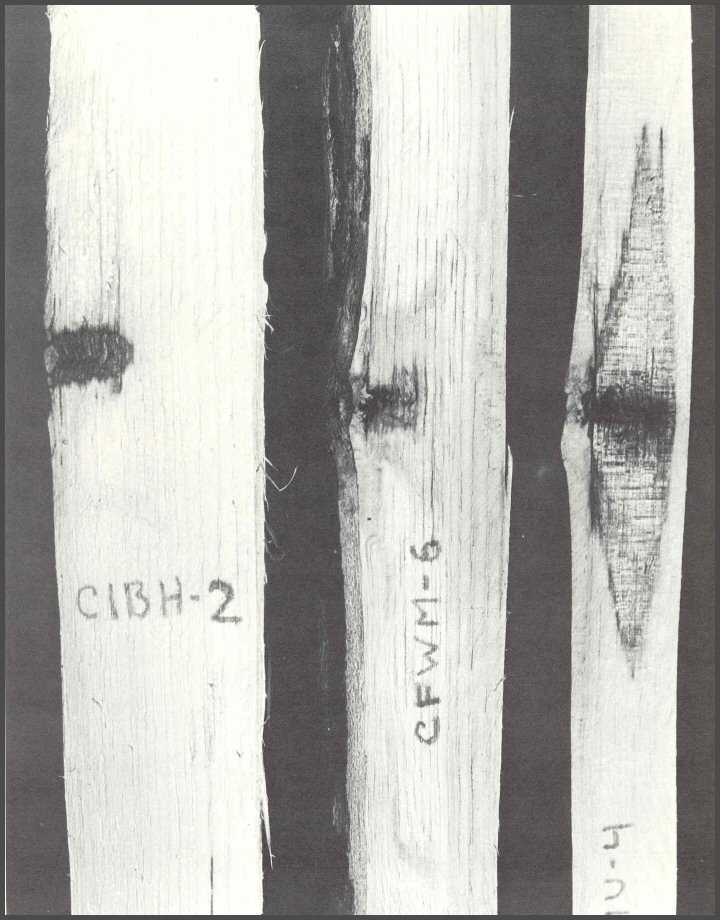
Pages 136-137
Page 138 is blank.
Pruning
Pruning properly done is the best treatment for trees. Pruning improperly done is the worst injury that can be found on trees worldwide. Branches are either cut leaving a long stub, or cut so close to the trunk that a trunk wound results. The close cut, or cut that is flush to the trunk or larger supporting branch, is called a flush cut. Such cuts have been recommended for hundreds of years. Why flush cuts? A flush cut injures the larger supporting branch or trunk. When the larger stem is injured, it begins to form a callus. The formation of callus has been considered a sign of "healing". Therefore, the idea was, to promote healing, cut branches flush. The more flush, the larger the callus, therefore the better the "healing". We now know that trees do not replace injured wood; callus is formed by the new growth rings that continue to grow after the pruning cut. Large branches cut flush will form large oval callus rings. When the center decays away, a cavity is formed. Large flush cuts are major causes of cavities. Here are some photos that show proper and improper pruning, and the internal results.
Page 139
96. The branch bark ridge (BBR) (arrows) is very pronounced on this paper birch sample. The cut is at the proper angle. The BBR forms as the enlarging branch pushes against the enlarging stem. The branch enlarges as an expanding cylinder, and so does the stem. But, the two expanding cylinders are at an angle, and the meeting of the two constantly expanding cylinders produces the BBR at the crotch of the branch. The raised bark is carried on the bark as a ridge. The lowest point of the BBR shows where the branch started as a bud.
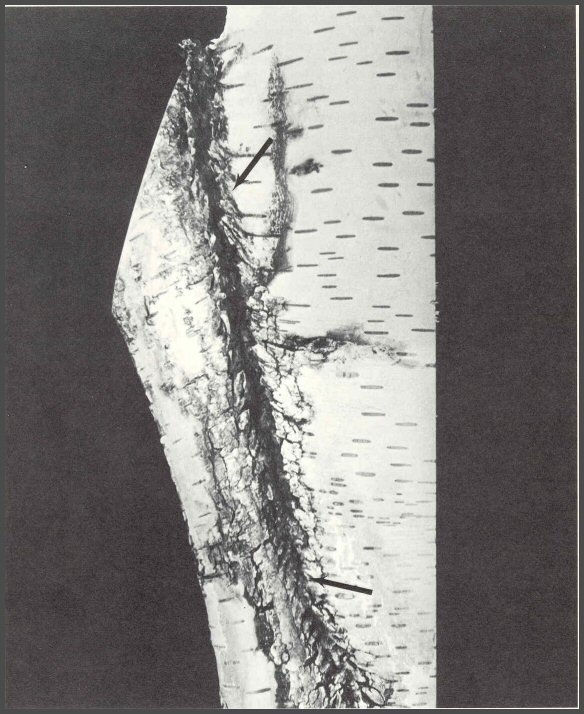
Page 140-141
97. Dissection of the birch sample shown in the previous figure shows the inner hard tissues that separated the developing branch from the expanding stem. Target 1 shows that the trunk has not been wounded. Target 2 is the part where the expanding circle of the trunk meets the expanding circle of the branch. Tissues below target 2 are trunk tissues. If a straight line were drawn as shown, from target 1 downward, Angle A to the BBR equals Angle B to the proper angle of cut. When in doubt about target 2, the straight line can be "drawn" in your mind on the outside of the stem, and the proper angle of cut determined very easily.
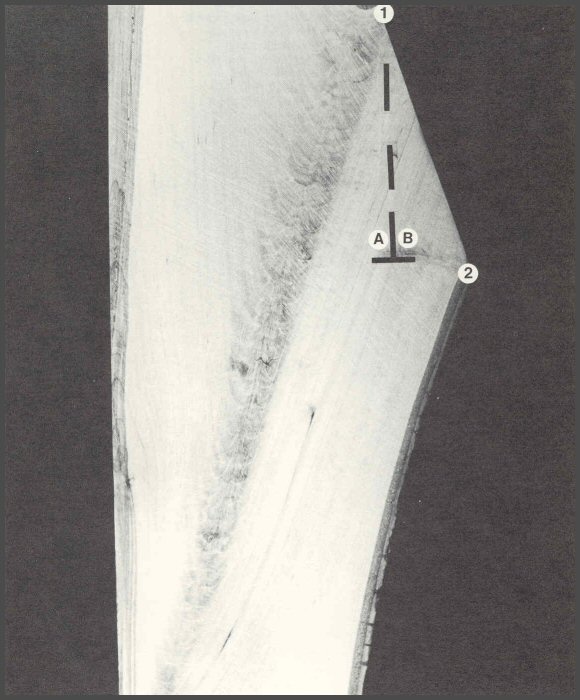
Page 142-143
98. Properly cut living branch on a red maple. Note that the hard inner tissues that separate the branches from the stem start at the point where the buds were set on the end of the twig (arrow). The hard inner tissues that are shown as the BBR on the outside separate the two branches from the trunk. The small branch on the right died, and it was shed. Trees do not cast off branches; the trees wall off the branch, decay spreads downward to the branch base, and the weakened branch falls away. All properly shed branches will have a small pocket of walled-off decayed wood at the branch base. The decay seldom spreads; it is walled off in the branch
compartment.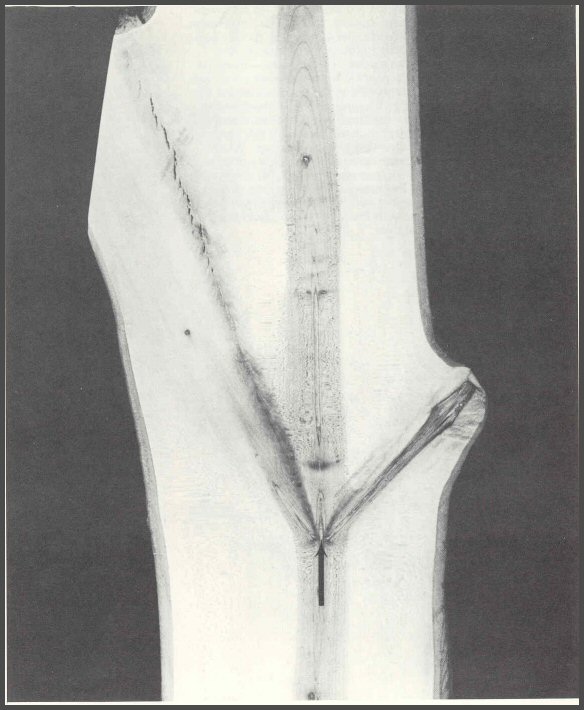
Pages 144-145
99. Dissections of a red maple stem showing a dead branch and its union with the living trunk. As branches wane and die, many microorganisms begin to infect the dying and dead tissues. Decay-causing fungi usually infect and begin to spread downward to the branch base, or the branch collar. The branch collar is the swollen basal tissue-trunk tissue. As the branch dies and as microorganisms spread downward, the tree begins to form a boundary of chemicals at the position where the last area of branch tissue is enveloped by trunk tissue. In hardwoods, the boundary contains a high concentration of phenol-based materials, many of which have been oxidized, and thus act to inhibit the spread of many microorganisms, especially the decay-causing fungi. When pruning dead and dying branches, great care must be taken not to remove the protective boundary zone. Do not leave a stub. Do not flush cut. Cut as shown in the figure. Do not remove the living ring of wood that surrounds dead branches. Note the well-compartmentalized pocket of decayed wood associated with the small lower dead branch core wood. The inner BBR is also shown.
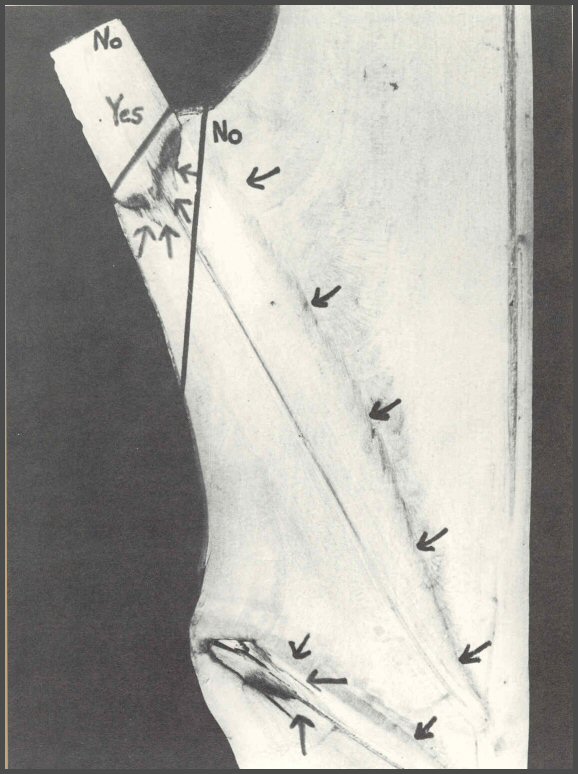
Pages 146-147
100. A yellow birch pruned in January, 1981, and dissected in July, 1981. Upper branch properly pruned, lower branch improperly pruned.
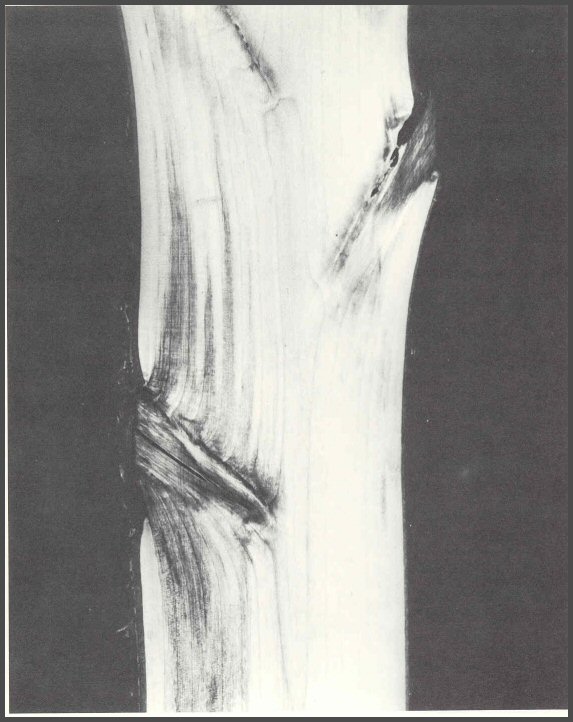
Pages 148-149
101. Improper cut on left, and proper cut on right, of a white pine after 1 year.
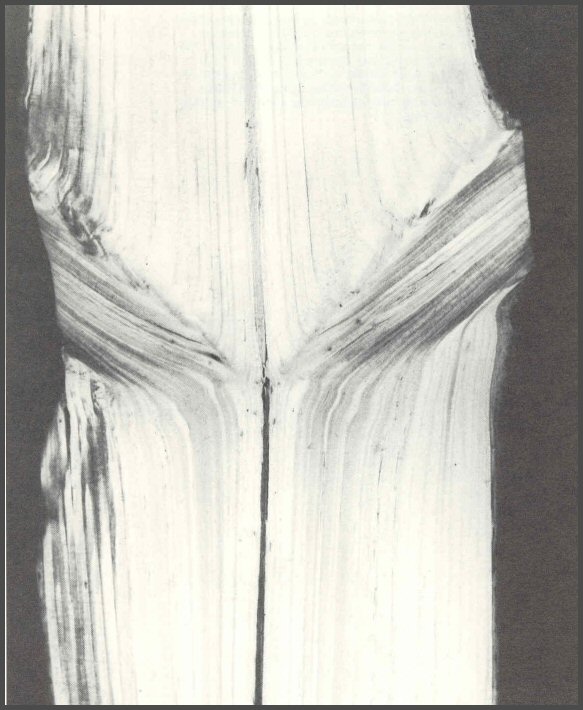
Pages 150-151